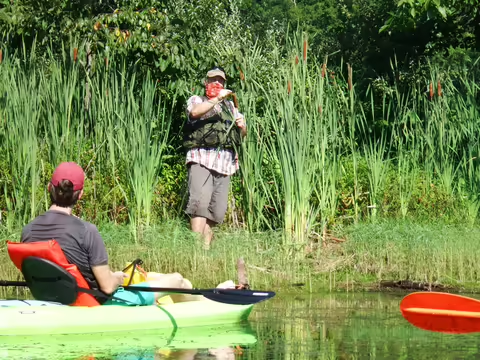
SOUTHERN ILLINOIS – It is just before 8 a.m. at Devils Kitchen Lake in Southern Illinois. The mid-August sun is already hot, and a small group unloads their kayaks, eager to get going.
Against a stunning backdrop of towering bluffs, all eyes are focused on the water looking for cattails, bullrushes, hibiscus, or any other plants they could find.
“Wetlands have a different suite of species that we don’t always get to look at because they’re harder to get to,” says Christopher Evans, a University of Illinois Extension Forester. “There’s no other way to look at them without being on a boat.”
Devils Kitchen Lake is a deep, clear 810-acre reservoir with an undeveloped shoreline surrounded by the forests of the Crab Orchard National Wildlife Refuge. With a laminated plant list in hand, participants paddled three miles on a botanical identification tour spotting more than 40 species of aquatic and wetland plants.
When they found a new species, the group circled around to see it, or if it was a flood plain or wetland species, Evans would hop onto shore and talk about its features and answer questions.
Learning to identify plants is tricky, so it helps to have an expert along in the field.
“Plant identification is sometimes overwhelming,” Evans said. “Having someone in the field to show you and answer questions helps people get over the roadblocks.”
Until recently, in-person Extension programs such as this have been off limits due to COVID-19 restrictions. But being out on the lake in individual kayaks allowed for the two eight-person tours to social distance safely. Participants wore facial coverings when loading and unloading boats.
Katie Phillips came out for the morning tour to enjoy some time on the water while learning. She took the Illinois Master Naturalist training in 2019 and wanted a refresher on plant identification.
“Some things that I thought were aquatic plants were actually algae,” Phillips says. “But even if you didn’t care about botany it was nice beautiful day to be out.”
One side effect of the pandemic has been an increased interest in outdoor activities.
“So many people are getting outside more than in the past, Evans says. “There’s a lot of interest in knowing more about the outside world and experiencing nature.”
The forestry team plans on hosting more kayak tours at other lakes in the future to explore different habitats. Illinois Extension staff provide firsthand experiences like to introduce people to the natural world and build a sense of appreciation for it.
“The less you know about things the less you understand their value and need for protection,” Evans says.
This event was co-sponsored by the University of Illinois Extension Forestry program and the Southern Chapter of the Illinois Native Plant Society.
Illinois Extension leads public outreach for University of Illinois by translating research into action plans that allow Illinois families, businesses, and community leaders to solve problems, make informed decisions, and adapt to changes and opportunities.
